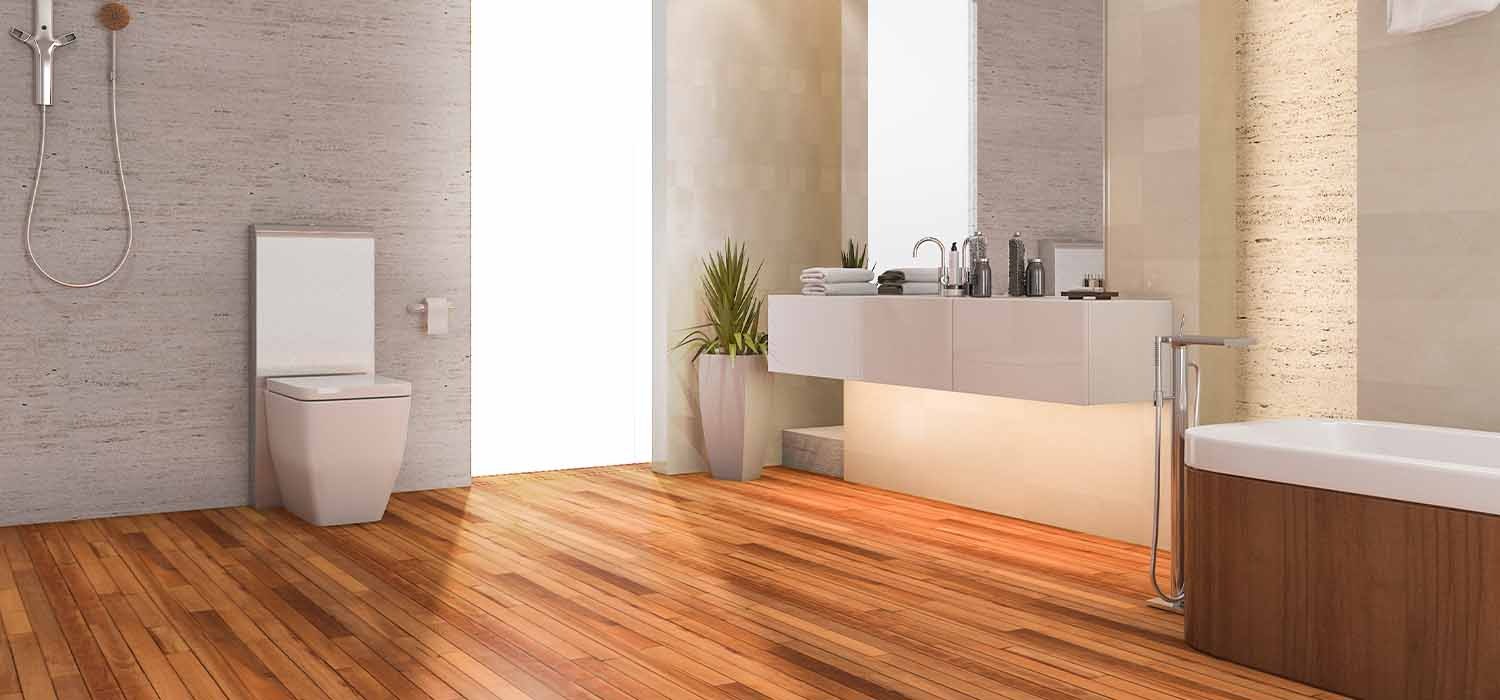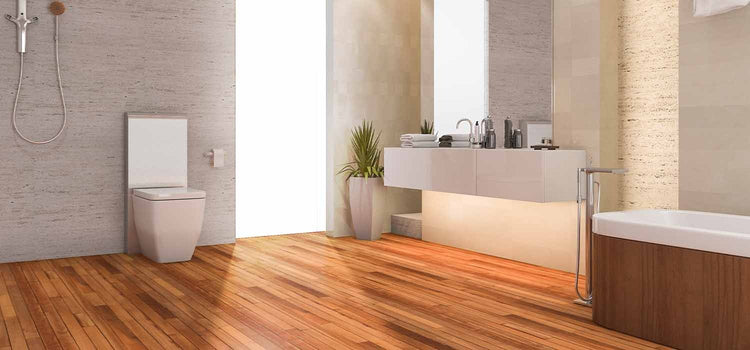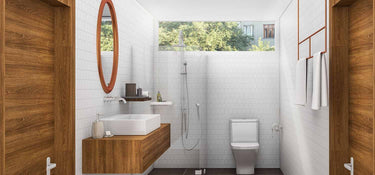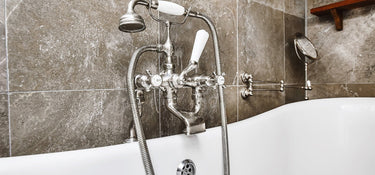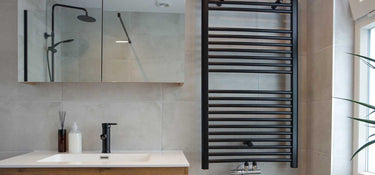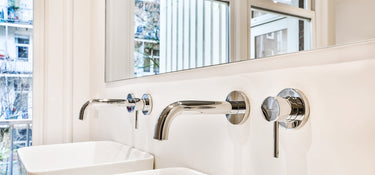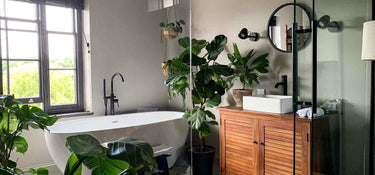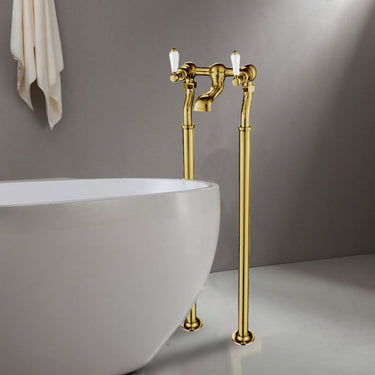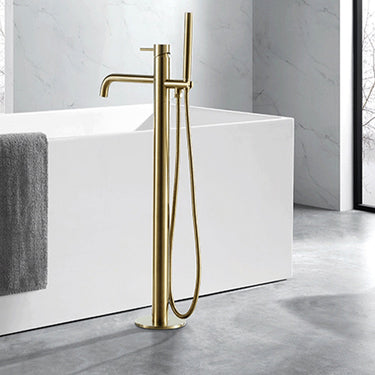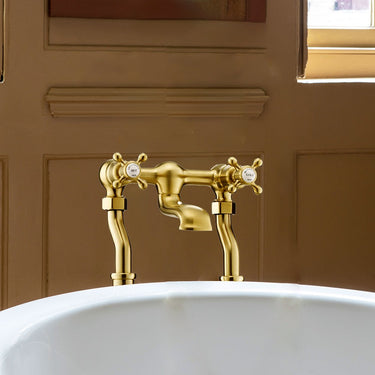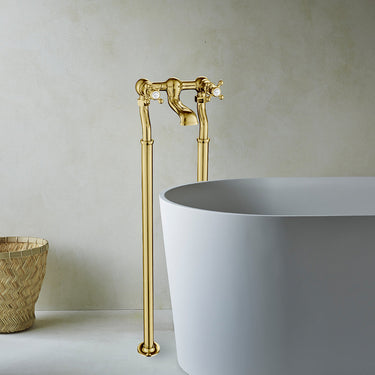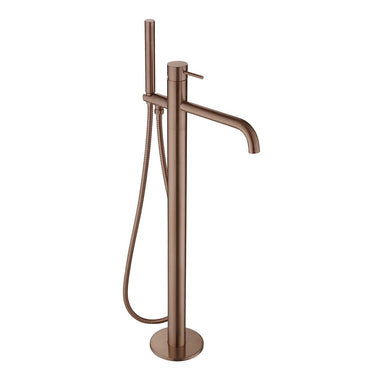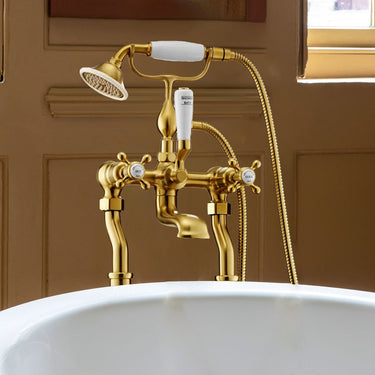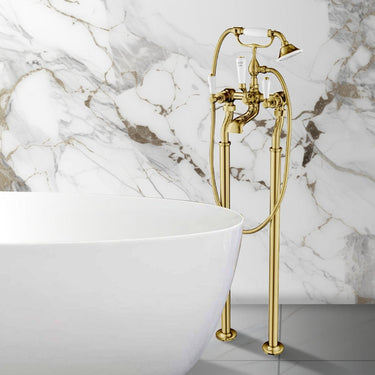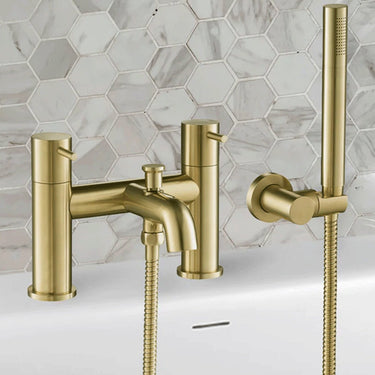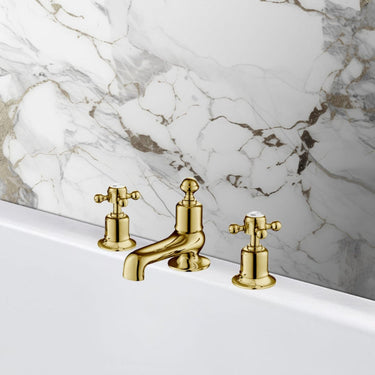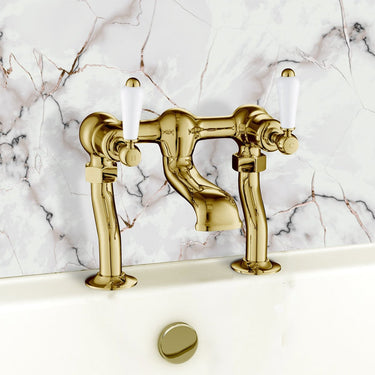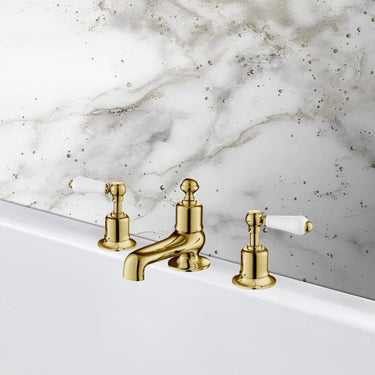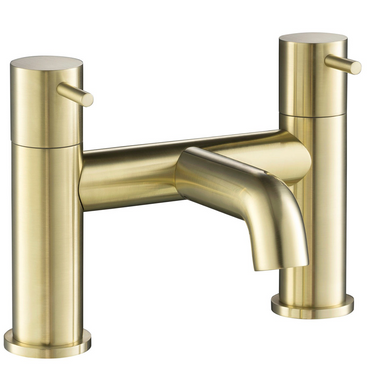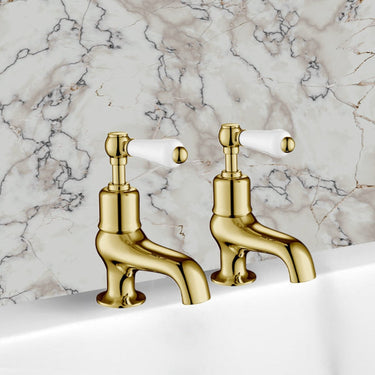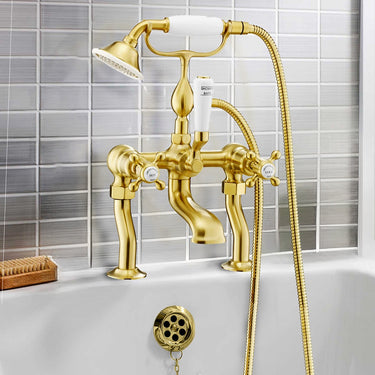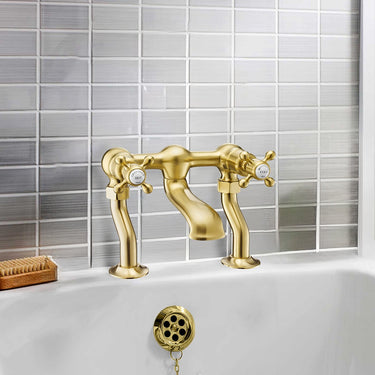Bathroom Flooring Guide: How to Choose the Best Flooring for Your Bathroom
Table Of Contents:
-
Introduction
→ -
Freestanding Bath Taps
→ -
Why Bathroom Flooring Matters
→ -
Popular Bathroom Flooring Options
→ -
Considerations for Bathroom Flooring
→ -
Choosing the Right Bathroom Flooring
→ -
How to Measure Bathroom Flooring?
→ -
Understanding the Size of Bathroom Floors: A Guide to Measurements
→ -
Cost of Bathroom Flooring: A Comprehensive Guide
→ -
Maintenance and Cleaning of Bathroom Flooring
→ -
Conclusion: The Right Bathroom Flooring for You
→ -
FAQs
→
Introduction
Choosing the right bathroom flooring is essential for both aesthetics and functionality. The bathroom is one of the most-used rooms in the home, and the flooring must not only look good but also withstand moisture, temperature changes, and high foot traffic. With so many options available, selecting the right material can be overwhelming. In this comprehensive bathroom flooring guide, we’ll explore the best options, their benefits, and tips to help you make an informed decision that suits your style and budget.
Why Bathroom Flooring Matters
Bathroom flooring isn’t just about style; it needs to be durable, moisture-resistant, and easy to clean. Since bathrooms are exposed to high levels of humidity and moisture, selecting water-resistant flooring options is crucial. A good bathroom floor should also be slip-resistant to ensure safety, especially in wet conditions.
Popular Bathroom Flooring Options
Each bathroom has unique needs, whether it’s a small ensuite, family bathroom, or luxurious master bathroom. Here are the most popular bathroom flooring options, along with their benefits and tips for choosing the best fit for your space.

Ceramic or Porcelain Tiles
Ceramic and porcelain tiles are among the most common choices for bathroom flooring due to their durability and water resistance. These tiles can withstand moisture and high humidity, making them perfect for bathrooms. Available in a wide range of colors, sizes, and finishes, they offer flexibility in design and can mimic the appearance of other materials like wood or stone. One of the major advantages of ceramic and porcelain tiles is their easy maintenance—simply wipe them down for a clean, shiny surface. However, tiles can feel cold underfoot, particularly in the winter months, so installing underfloor heating may be a good option for added comfort.
Vinyl Flooring
Vinyl is another popular choice for bathroom flooring, and it's known for being affordable, water-resistant, and comfortable underfoot. Modern vinyl flooring options come in a variety of finishes, including realistic wood and stone looks. Vinyl is easy to install and maintain, and its softness makes it more comfortable to stand on compared to other hard surfaces. While it may not be as durable as tile or stone, vinyl flooring can last a long time with proper care. It is also ideal for homeowners on a budget, providing a stylish solution at a fraction of the cost of more expensive materials.
Natural Stone Flooring (Marble, Granite, Slate)
For a luxurious and timeless look, natural stone flooring is an excellent choice. Marble, granite, and slate offer elegant aesthetics and are highly durable. They can handle moisture when properly sealed and can withstand the wear and tear of daily use. Natural stone also adds a unique touch, as no two pieces are identical, providing a one-of-a-kind design in your bathroom. However, stone flooring can be expensive, both in terms of the material and installation. It also requires regular maintenance, including sealing to protect it from stains and moisture.
Laminate Flooring
Laminate flooring is a cost-effective alternative that offers the look of high-end materials like wood or stone. It is available in a wide variety of designs and can be a great way to achieve the appearance of a more expensive floor without the hefty price tag. While laminate is resistant to moisture, it's not entirely waterproof, so it’s essential to ensure proper sealing around edges and seams to prevent water damage. Laminate is also easy to install and clean, making it an appealing choice for DIY projects. However, it may not be as durable as options like tiles or natural stone and can suffer from wear and tear over time.

Wood or Engineered Wood Flooring
Wood flooring can create a warm, inviting atmosphere in the bathroom, especially if you prefer a natural aesthetic. Solid wood floors are generally not recommended for bathrooms due to their susceptibility to water damage. However, engineered wood flooring offers better moisture resistance and is a good option for bathrooms. It features a veneer of real wood over a plywood base, which makes it more durable and less prone to swelling or warping. Engineered wood provides the beauty of real wood while being better suited for bathrooms than traditional solid wood floors. Keep in mind that wood floors require regular sealing and maintenance to protect them from moisture and spills.
Rubber Flooring
Rubber flooring is an excellent choice for those prioritizing safety and comfort. It is naturally slip-resistant, making it ideal for wet bathrooms where slipping is a concern. Rubber is also soft underfoot, offering a cushioned surface that is comfortable to stand on for extended periods. It is easy to clean and highly durable, withstanding heavy foot traffic and moisture. While it may not have the high-end appearance of materials like marble or wood, rubber flooring is a practical and functional choice for family bathrooms, wet rooms, or spaces where safety is the top priority.
Considerations for Bathroom Flooring
When choosing bathroom flooring, it’s essential to think beyond just the aesthetics. The most important consideration is moisture resistance. Since bathrooms are exposed to high levels of humidity and moisture, choosing water-resistant flooring options like tiles, vinyl, or engineered wood is crucial. Durability is also an important factor, especially in high-traffic bathrooms, so selecting hard-wearing materials like porcelain, stone, or luxury vinyl will ensure your floor lasts for many years. Comfort is another key consideration—bathrooms are spaces where you often stand for long periods, so soft materials like vinyl or rubber can provide a more comfortable experience.
Maintenance is another aspect to consider. Some flooring materials, such as tiles or stone, require regular sealing and grout cleaning, while options like vinyl or laminate are low-maintenance and easy to clean. Budget is also a key factor, with cheaper options like vinyl and laminate offering affordable solutions, while high-end materials like natural stone can be more expensive. Finally, think about your bathroom’s overall style. Whether you’re aiming for a modern, rustic, or classic look, there are flooring options available to suit every design preference.

Choosing the Right Bathroom Flooring
When selecting flooring for your bathroom, it's crucial to consider factors like moisture resistance, durability, safety, and style. The bathroom is a high-traffic, moisture-heavy space, so the right flooring will help maintain both functionality and aesthetics. Here’s a guide to help you choose the best flooring for your bathroom.
1. Moisture Resistance
Bathrooms are prone to high levels of humidity and water exposure, making moisture resistance one of the most important factors when choosing bathroom flooring. Materials that can withstand water and moisture will last longer and remain in better condition.
-
Waterproof Materials: Look for materials specifically designed to be water-resistant or waterproof, such as vinyl, porcelain, and ceramic tiles, or natural stone like granite and slate.
-
Avoid Wood: Solid wood is not ideal for bathrooms as it can warp, swell, and rot with consistent exposure to moisture. However, engineered wood or water-resistant laminate can be a better choice for those seeking a wood-like aesthetic.
2. Durability and Maintenance
Your bathroom floor needs to withstand daily use, water spills, and foot traffic without showing signs of wear. Durability and ease of maintenance are essential considerations.
-
Tiles (Porcelain and Ceramic): Both porcelain and ceramic tiles are highly durable, scratch-resistant, and easy to clean, making them excellent choices for bathrooms. Porcelain tiles are denser and more resistant to water absorption than ceramic, making them ideal for high-moisture areas.
-
Vinyl Flooring: Modern luxury vinyl flooring (LVT) offers impressive durability while being soft underfoot. It's also incredibly easy to maintain, requiring just regular cleaning to keep it looking new.
-
Natural Stone: Stone options like granite, slate, or marble are extremely durable and elegant. However, they may require sealing to protect against moisture and stains.
3. Safety (Slip Resistance)
Safety is a top priority in any bathroom, especially when the floor is wet. Choosing flooring with slip-resistant properties will help prevent accidents.
-
Textured Tiles: Look for textured ceramic or porcelain tiles with a non-slip surface. Tiles that have a matte or slightly rough finish tend to offer better traction compared to glossy options.
-
Vinyl and Rubber: Luxury vinyl tiles (LVT) and rubber flooring are both slip-resistant and soft, making them a great choice for bathrooms with kids or elderly individuals.
-
Stone Tiles: While stone flooring is naturally slip-resistant when textured, highly polished stones like marble or granite can be slippery, so be cautious when choosing these materials.
4. Style and Aesthetic
The floor you choose should complement the overall design and style of your bathroom. Whether you prefer a modern, traditional, or rustic look, there are plenty of options to match your taste.
-
Tiles: Tiles come in a wide range of designs, colors, and patterns. You can opt for classic white subway tiles, geometric designs, or even wood-look tiles to create a specific atmosphere in your bathroom.
-
Vinyl: Vinyl comes in an array of styles, from wood-look to stone-look designs. Its versatility makes it easy to match different bathroom aesthetics.
-
Stone: Natural stone like marble, slate, or granite can create a luxurious, high-end look but may require more maintenance.
5. Comfort Underfoot
Since bathrooms can be a cold, hard environment, comfort underfoot can make a big difference. Some flooring options are more comfortable to walk on than others.
-
Vinyl Flooring: Luxury vinyl is softer than tiles and provides a more comfortable surface to stand on, making it ideal for long periods of use.
-
Cork Flooring: Cork is an excellent option for comfort. It’s soft, warm underfoot, and offers natural moisture resistance, making it a good alternative to traditional tile or wood.
-
Carpet: While not typically recommended for bathrooms due to moisture concerns, a small area rug or mat in dry areas can add warmth and comfort.
6. Budget Considerations
Your budget will play a significant role in your choice of bathroom flooring. Some materials may require a larger upfront investment, but they could save you money in the long run due to their durability and low maintenance needs.
-
Budget-Friendly Options: Vinyl and laminate are typically more affordable than natural stone or high-end ceramic tiles. They still offer excellent durability and water resistance.
-
Mid-Range Options: Ceramic and porcelain tiles offer a balance of durability and cost-effectiveness, with a variety of designs and finishes.
-
High-End Options: Natural stone (like marble, granite, or slate) can be more expensive but offers timeless beauty and a luxurious feel. It may require additional maintenance, such as sealing, to keep it looking pristine.
Popular Bathroom Flooring Options
-
Ceramic & Porcelain Tiles: Versatile, durable, and available in a wide variety of designs.
-
Vinyl Flooring: Affordable, water-resistant, and available in various styles, including wood-look and stone-look options.
-
Natural Stone (Marble, Slate, Granite): Elegant, durable, and timeless, but may require sealing and more maintenance.
-
Engineered Wood & Laminate: Offers the appearance of wood with better moisture resistance than solid wood.
-
Cork Flooring: Soft, warm, and eco-friendly with natural moisture resistance.
-
Rubber Flooring: Slip-resistant, comfortable, and easy to maintain, ideal for family bathrooms.
Choosing the right bathroom flooring involves a balance of practicality, aesthetics, and safety. Moisture resistance, durability, slip resistance, comfort, and style should all be considered to ensure your flooring serves its purpose effectively. Ceramic, porcelain, and vinyl are the most popular choices, but materials like stone and cork also offer unique advantages. Select the flooring that best fits your budget, bathroom needs, and design preferences to create a space that’s both functional and beautiful.

How to Measure Bathroom Flooring?
Measuring your bathroom floor correctly is essential for ensuring you purchase the right amount of flooring material. Whether you're laying tiles, vinyl, or another type of flooring, here's a step-by-step guide to help you measure your bathroom flooring accurately:
What You’ll Need:
-
Tape measure or ruler
-
Pencil and paper (or a digital device for notes)
-
Calculator
-
Square or a measuring tool for angles
Step 1: Measure the Length and Width of the Bathroom
-
Start with the length:
Measure from one end of the bathroom to the other along the longest wall. Record this measurement in inches or centimeters, depending on your preferred system of measurement. -
Measure the width:
Measure from one side of the room to the other, across the shortest part of the bathroom. This will give you the width measurement. -
Record the measurements:
Write down both the length and width of the room. These measurements will be essential for calculating the total square footage of the floor.
Step 2: Measure for Irregular Shapes (if applicable)
If your bathroom isn’t a simple rectangle or square, you may have alcoves, curves, or other irregular features to account for.
-
Divide the room into smaller sections:
If your bathroom has an odd shape, break it into smaller, rectangular or square sections. Measure the length and width of each section individually. -
Measure curves carefully:
For rounded areas, measure the diameter or radius and use an online area calculator for circles, or estimate the area by treating it as a segment of a rectangle or square. -
Add extra space for cuts:
If you’re using tiles or other materials that need cutting to fit around features like sinks, toilets, or tubs, add an extra 5–10% to your measurements to account for waste.
Step 3: Calculate the Total Square Footage (or Square Meters)
Once you have the length and width measurements, multiply them together to find the square footage.
-
Formula:
Square footage = Length x Width
For example, if your bathroom is 3 meters (length) by 2 meters (width), the calculation would be:
-
3 meters x 2 meters = 6 square meters
If you're using inches, you'll need to divide the total square inches by 144 (the number of square inches in a square foot) to convert to square feet.
-
Formula for square feet (if measuring in inches):
Square feet = (Length in inches x Width in inches) ÷ 144
Step 4: Account for Additional Features (Doors, Fixtures, etc.)
Consider any features that might reduce the amount of flooring you need to buy:
-
Subtract the area of the door: If the bathroom has a door that you don’t need to cover, measure the door’s height and width and subtract the area from the total square footage.
-
Subtract fixtures: If there are permanent fixtures such as toilets, sinks, or bathtubs that won’t require flooring beneath them, measure their size and subtract the area from your total.
Step 5: Add Extra Material for Waste and Cuts
When cutting flooring around the edges of the room or around fixtures, it’s common to have waste. Add around 5–10% to your total square footage to account for mistakes, cuts, and miscalculations.
For example:
-
If your bathroom measures 6 square meters, adding 10% for waste would give you an additional 0.6 square meters.
-
The total amount you need would be 6.6 square meters.
Step 6: Double Check the Measurements
Before ordering your flooring materials, double-check your measurements to avoid mistakes. It's easy to miss details like angles, curves, or irregular sections, so carefully review your room’s layout and adjust the measurements as needed.
Step 7: Calculate for Tiles or Rolls
If you're using tiles, roll-out vinyl, or sheet vinyl, remember to check the size of the tiles or rolls. Tiles are usually sold by square footage, so use your measurements to determine how many tiles you need.
For example:
-
If your tiles are 0.25 square meters each, and you need 6.6 square meters of flooring, you would need approximately 27 tiles (6.6 ÷ 0.25 = 26.4, round up to 27).
If you're working with vinyl or roll-out materials, check the roll’s coverage area and make sure it matches your room size.
Step 8: Confirm with a Professional (Optional)
If you're uncertain about your measurements, or if you have a complex bathroom layout, consider consulting a professional flooring expert or installer. They can help you with accurate measurements and advice on the best materials for your space.
Measuring bathroom flooring accurately is essential to ensure you purchase the right amount of material. By following these simple steps, you can calculate the square footage, account for waste, and ensure that your flooring fits perfectly. Double-check your measurements to avoid mistakes, and consider adding a little extra for any potential cuts and future repairs.
Understanding the Size of Bathroom Floors: A Guide to Measurements
The size of a bathroom floor can vary significantly based on the space available and the layout of the bathroom. Knowing your bathroom's floor size is essential when planning for flooring installation, as it helps determine how much material you'll need. Bathroom sizes are typically measured in square feet or square meters. Here’s an overview of common bathroom floor sizes:
1. Small Bathroom
-
Size: Typically ranges from 30 to 70 square feet (2.8 to 6.5 square meters).
-
Common Features: These bathrooms usually contain a toilet, sink, and a small shower or bathtub.
-
Flooring Needs: For smaller bathrooms, it’s important to choose materials that can help make the room feel larger, such as light-colored tiles, large-format tiles, or vinyl.
2. Medium-Sized Bathroom
-
Size: Generally falls between 70 to 120 square feet (6.5 to 11.1 square meters).
-
Common Features: Medium-sized bathrooms often include a bathtub or shower, a toilet, and a sink, with additional space for storage or a small vanity.
-
Flooring Needs: With more space, you have the flexibility to mix materials, use different patterns, or include accent tiles to create a stylish look.
3. Large Bathroom
-
Size: Typically between 120 to 200 square feet (11.1 to 18.6 square meters) or more.
-
Common Features: Large bathrooms often include both a shower and bathtub, a toilet, sinks, and ample storage or closet space.
-
Flooring Needs: Larger bathrooms offer opportunities for more creative designs, such as using large-format tiles, mosaic patterns, or mixing materials for a dynamic and luxurious finish.
4. Master Bathrooms / Ensuites
-
Size: These bathrooms can range from 150 to 300+ square feet (14 to 28 square meters) or more.
-
Common Features: Master bathrooms typically feature high-end elements such as double vanities, walk-in showers, large freestanding tubs, and substantial closet space.
-
Flooring Needs: The large space allows for premium materials like natural stone, wood-look tiles, heated flooring, or elegant tile designs to match the luxury feel of the room.
How to Measure Your Bathroom Floor
To determine the exact size of your bathroom floor, follow these steps:
-
Measure the length and width of the bathroom.
-
Multiply the two measurements to calculate the square footage or square meters (Length x Width = Area).
-
If the bathroom has any alcoves or irregular shapes, divide the room into smaller sections, measure each, and then add the areas together.
Example:
-
If your bathroom measures 3 meters by 2.5 meters, the area would be:
-
3m x 2.5m = 7.5 square meters.
The size of a bathroom floor can vary from small, compact spaces to large, luxurious master bathrooms. Understanding your bathroom’s size will help you purchase the right amount of flooring material and create a space that suits your design preferences. Whether it’s a small powder room or a spacious ensuite, knowing your bathroom’s exact measurements is key to achieving a perfect fit for your flooring.
Cost of Bathroom Flooring: A Comprehensive Guide
When planning a bathroom renovation or new installation, the cost of flooring is one of the most important considerations. The price can vary widely based on the type of material, size of the bathroom, and labor costs for installation. Here's an overview of the typical costs of bathroom flooring in the UK, broken down by material type.
1. Ceramic and Porcelain Tiles
-
Cost Range: £15 to £50 per square meter
-
Overview: Ceramic and porcelain tiles are among the most popular flooring choices for bathrooms due to their water resistance, durability, and variety of styles. Porcelain tiles tend to be a bit more expensive than ceramic but are also more water-resistant and harder-wearing.
-
Installation Cost: £20 to £40 per square meter
-
Pros: Wide variety of designs, durable, easy to clean, water-resistant.
-
Cons: Cold underfoot, requires professional installation for best results.
2. Vinyl Flooring
-
Cost Range: £10 to £40 per square meter
-
Overview: Vinyl is a budget-friendly option for bathroom flooring. It’s available in sheets, tiles, and planks and is water-resistant, making it ideal for bathrooms. Luxury vinyl tiles (LVT) or planks are more durable and have a higher-end look, often resembling wood or stone.
-
Installation Cost: £10 to £20 per square meter
-
Pros: Affordable, easy to maintain, warm underfoot, DIY installation possible.
-
Cons: May not have the same longevity as tiles or stone.
3. Natural Stone Flooring (Granite, Marble, Slate)
-
Cost Range: £30 to £100 per square meter
-
Overview: Natural stone tiles like granite, marble, or slate create a luxurious and timeless look for bathrooms. They are highly durable and water-resistant, but they may require sealing to prevent staining or damage from moisture.
-
Installation Cost: £40 to £60 per square meter
-
Pros: Elegant, long-lasting, adds value to the home, unique appearance.
-
Cons: Expensive, requires maintenance (sealing), cold underfoot.
4. Engineered Wood
-
Cost Range: £20 to £50 per square meter
-
Overview: Engineered wood is a popular option for bathrooms that want a warm, natural look without the risks of solid wood flooring. It’s more water-resistant than solid wood but still requires care to avoid water damage.
-
Installation Cost: £15 to £30 per square meter
-
Pros: Warm, attractive, available in a variety of finishes, relatively durable.
-
Cons: Not as moisture-resistant as tiles or vinyl, may need regular sealing or maintenance.
5. Laminate Flooring
-
Cost Range: £10 to £30 per square meter
-
Overview: Laminate is a budget-friendly option that mimics the look of wood or stone. It is water-resistant but not waterproof, so it's better suited for bathrooms with minimal water exposure.
-
Installation Cost: £10 to £20 per square meter
-
Pros: Affordable, easy to install (DIY-friendly), wide range of styles.
-
Cons: Can be damaged by excessive moisture, may not last as long as other materials.
6. Rubber Flooring
-
Cost Range: £20 to £50 per square meter
-
Overview: Rubber is a durable and slip-resistant material, making it a safe choice for bathrooms. It is available in sheets or tiles and provides a comfortable surface underfoot.
-
Installation Cost: £20 to £30 per square meter
-
Pros: Slip-resistant, durable, soft underfoot, easy to maintain.
-
Cons: Limited design options, may not have the same aesthetic appeal as tiles or wood.
7. Cork Flooring
-
Cost Range: £20 to £40 per square meter
-
Overview: Cork is an eco-friendly option with natural water resistance. It is soft and warm underfoot, making it a comfortable choice for bathrooms, although it requires sealing to prevent water damage.
-
Installation Cost: £15 to £25 per square meter
-
Pros: Eco-friendly, comfortable, warm underfoot.
-
Cons: Needs sealing, may not be as durable as harder materials like tile.
8. Concrete Flooring
-
Cost Range: £25 to £60 per square meter
-
Overview: Polished concrete can give a sleek, modern look to bathrooms. It’s durable and easy to maintain but may require sealing to protect it from moisture.
-
Installation Cost: £30 to £50 per square meter
-
Pros: Modern, durable, low-maintenance, unique look.
-
Cons: Cold underfoot, may require regular sealing.
Additional Costs to Consider
-
Subfloor Preparation: If your existing subfloor isn’t in the best condition, you may need to invest in subfloor preparation, which could cost an additional £5 to £15 per square meter.
-
Grouting and Sealing: For materials like tiles or natural stone, grouting and sealing will add to the overall cost. Grouting typically costs around £2 to £5 per square meter, while sealing stone floors may add £5 to £10 per square meter.
The cost of bathroom flooring can vary greatly depending on the material chosen. Vinyl and laminate offer budget-friendly options, while ceramic tiles, natural stone, and engineered wood fall on the more expensive end. When calculating your total flooring cost, remember to account for installation, subfloor preparation, and any additional treatments like sealing. Ultimately, the right choice depends on your budget, design preferences, and the level of maintenance you're prepared to undertake.

Maintenance and Cleaning of Bathroom Flooring
Regardless of the type of bathroom flooring you have—whether it's tiles, vinyl, wood, or stone—regular cleaning and maintenance are essential to keeping it in top condition. Each material has its own unique care needs, but there are common practices you can follow to ensure your bathroom floor remains durable, clean, and looking great.
General Maintenance Tips for All Bathroom Flooring Types
-
Regular Sweeping or Vacuuming:
-
Purpose: Dirt, dust, and debris can cause scratches and abrasions on your bathroom floor. Sweeping or vacuuming daily or at least a few times a week helps prevent buildup and ensures the floor stays clean.
-
Recommendation: Use a soft-bristled broom or a vacuum with a soft floor attachment to avoid damage.
-
Wipe Up Spills Immediately:
-
Purpose: Bathroom floors are often exposed to water, soap, and other liquids. Standing moisture can damage most types of flooring over time, so it's essential to clean up spills immediately.
-
Recommendation: Always use a clean cloth or paper towel to blot up any spills, especially from water or cleaning products.
-
Avoid Excessive Water:
-
Purpose: Even moisture-resistant floors, like vinyl or tiles, can suffer from prolonged exposure to standing water. Excessive water can seep into edges and corners, leading to potential damage or mildew growth.
-
Recommendation: When mopping, ensure the mop is damp, not wet, and avoid soaking the floor. Dry the floor after cleaning.
-
Use Gentle Cleaning Products:
-
Purpose: Harsh chemicals or abrasive cleaners can cause discoloration, damage the surface, or wear away protective finishes.
-
Recommendation: Use a mild, pH-balanced cleaner appropriate for your flooring type. Always check the manufacturer's recommendations for cleaning products.
Cleaning Tips for All Bathroom Flooring Types
-
Weekly Cleaning:
-
Purpose: Regular mopping helps remove dirt, soap scum, and other residues that can accumulate over time, ensuring your floor stays fresh and clean.
-
Recommendation: Mop the floor weekly using a cleaner that is safe for your flooring type. Avoid acidic solutions (like vinegar) unless specifically recommended.
-
Stain Removal:
-
Purpose: Stains can occur from various sources like beauty products, soaps, or toilet cleaners. Left untreated, they may become harder to remove.
-
Recommendation: For light stains, use a soft cloth with a mild cleaner. For tougher stains, consider using a diluted mixture of water and dish soap or a commercial stain remover suitable for your floor material.
-
Avoid Harsh Scrubbing:
-
Purpose: Abrasive scrubbing can scratch or damage the surface of your flooring, leading to a dull appearance and potential long-term wear.
-
Recommendation: Always use a soft mop, sponge, or microfiber cloth. Avoid using steel wool or hard scrubbing brushes unless recommended by the manufacturer.
-
Dry After Cleaning:
-
Purpose: Standing water can cause moisture buildup, leading to potential damage, especially on wood and laminate floors.
-
Recommendation: After mopping, use a dry microfiber cloth or towel to absorb excess water and ensure the floor is dry to the touch.
Preventative Measures for Longer Lasting Floors
-
Use Rugs and Mats:
-
Purpose: Rugs and mats near the bathtub, sink, and shower can help absorb water, dirt, and grime, reducing the risk of water damage and preserving the floor's condition.
-
Recommendation: Use non-slip mats to prevent slips and falls, and wash the mats regularly to avoid dirt buildup.
-
Ventilation:
-
Purpose: Excess humidity and moisture in the bathroom can lead to mildew or mold growth, particularly in corners and on flooring seams.
-
Recommendation: Ensure good ventilation by using an extractor fan or opening a window after showers or baths. This will help maintain dry conditions and protect your floor from moisture-related damage.
-
Protect with Floor Sealant:
-
Purpose: Some floors, like natural stone or wood, may need additional protection against moisture and stains.
-
Recommendation: Apply a sealant to floors as needed. Stone floors (e.g., granite, marble) should be sealed annually to protect them from water and stains. Similarly, wood floors may benefit from regular sealing to prevent water damage.
-
Furniture Pads and Avoiding Heavy Dragging:
-
Purpose: Heavy furniture or sharp objects dragged across the floor can cause scratches or dents, particularly on softer materials like vinyl and laminate.
-
Recommendation: Use felt pads under furniture and avoid dragging heavy objects across the floor. If moving furniture is necessary, lift it instead of dragging.
Summary of Key Cleaning and Maintenance Points
-
Regularly sweep or vacuum to remove dirt and prevent scratches.
-
Blot up spills immediately to avoid water damage and stains.
-
Avoid excessive moisture during cleaning to prevent water damage, especially on wood and laminate.
-
Use gentle cleaning products appropriate for your floor type and avoid abrasive scrubbers.
-
Dry your floor after mopping to prevent water from pooling.
-
Use rugs and mats to catch dirt and water, especially in high-moisture areas.
-
Ensure proper ventilation in the bathroom to prevent mildew and mold growth.
-
Seal floors (especially stone or wood) to protect from stains and moisture damage.
With the right care, your bathroom flooring can remain beautiful and functional for years. While each material—whether vinyl, ceramic, stone, or wood—requires slightly different care, following general cleaning and maintenance practices will ensure your floor stays in top shape. Regular cleaning, proper ventilation, and preventative care are the keys to maintaining a pristine bathroom floor.
Conclusion: The Right Bathroom Flooring for You
Choosing the right flooring for your bathroom ultimately comes down to balancing aesthetics, functionality, and budget. Whether you opt for the timeless elegance of porcelain tiles, the luxurious feel of natural stone, or the comfort of vinyl, make sure the material you choose is durable, water-resistant, and easy to maintain. The best bathroom floor is one that complements your style while standing up to the demands of high moisture levels and daily use. By carefully considering all your options and priorities, you can create a bathroom floor that not only looks stunning but also performs well for years to come.
Frequently Asked Questions
The best flooring for a bathroom needs to be moisture-resistant, durable, and easy to maintain. Popular options include porcelain or ceramic tiles, luxury vinyl tiles (LVT), engineered wood, and natural stone. Each has its advantages, with tiles and vinyl being the most commonly recommended for their water resistance and ease of cleaning.
While traditional hardwood flooring is not ideal for bathrooms due to moisture concerns, engineered wood or water-resistant wood-look tiles are good alternatives. These options offer the appearance of wood without the risk of warping or damage from humidity and water exposure.
Yes, vinyl flooring is an excellent choice for bathrooms. It is water-resistant, easy to clean, and comes in a wide variety of designs, including options that mimic wood or stone. Luxury vinyl tiles (LVT) are especially durable and comfortable underfoot, making them a popular choice for bathroom floors.
Ceramic and porcelain tiles are among the best choices for bathroom flooring. They are waterproof, durable, and easy to maintain. Additionally, tiles come in a wide range of colors, sizes, and styles, offering great versatility to suit any bathroom aesthetic.
To avoid slips and falls, choose tiles with a textured or matte finish rather than shiny or glossy tiles. Many manufacturers offer tiles with slip-resistant ratings specifically designed for wet areas. Additionally, adding non-slip rugs or bath mats in high-risk areas can further improve safety.
Some types of bathroom flooring, such as vinyl planks or peel-and-stick tiles, can be installed by DIYers with basic tools and skills. However, for materials like ceramic or porcelain tiles or natural stone, professional installation is recommended for the best results, especially when it comes to proper sealing and ensuring water-tight finishes.
The lifespan of bathroom flooring varies depending on the material:
Ceramic and porcelain tiles can last 20+ years with proper maintenance.
Vinyl flooring can last around 10-20 years, depending on the quality and traffic.
Natural stone can last for decades but may require resealing periodically.
Engineered wood typically lasts 10-15 years in bathrooms if well-maintained.
Yes, area rugs or bath mats can be used to add comfort and warmth to bathroom floors. However, be sure to choose rugs with non-slip backing to prevent them from shifting when wet. Avoid using large, full-floor rugs that could retain moisture and potentially cause mold growth.
For tiles, sweep or vacuum regularly, and mop with a damp cloth and mild cleaner. Sealing grout lines can help prevent stains.
Vinyl flooring is easy to clean with a damp mop and mild detergent. Avoid harsh chemicals that could damage the finish.
For wood-like floors (engineered wood or laminate), use a soft cloth and a gentle wood cleaner. Avoid excessive water.
Stone flooring may need periodic sealing to protect against moisture damage.
Yes, you can install electric heated floors beneath ceramic, porcelain, and vinyl tiles. Many bathroom flooring options are compatible with underfloor heating systems, which can be a great luxury addition to keep the bathroom warm and comfortable during cold weather.
The cost of bathroom flooring depends on the material chosen:
Ceramic or porcelain tiles typically range from £15-£50 per square meter.
Vinyl costs around £10-£40 per square meter, depending on quality.
Engineered wood flooring can cost £20-£60 per square meter.
Natural stone such as marble or granite may range from £30-£100 per square meter. Installation costs will add to the total expense.
Yes, you can use the same floor tiles for bathroom walls, especially if you like a uniform look. Make sure to choose tiles that are designed for wall use or are rated for both wall and floor installation. Floor tiles are generally thicker and more durable, but wall tiles can be lighter and easier to work with.
To create the illusion of a larger bathroom, consider using light-colored tiles or vinyl flooring, as they can help make the space feel more open. Large-format tiles with minimal grout lines also work well in small bathrooms, as do tiles with subtle patterns or neutral tones. Laying tiles in a diagonal pattern can also create a sense of more space.


